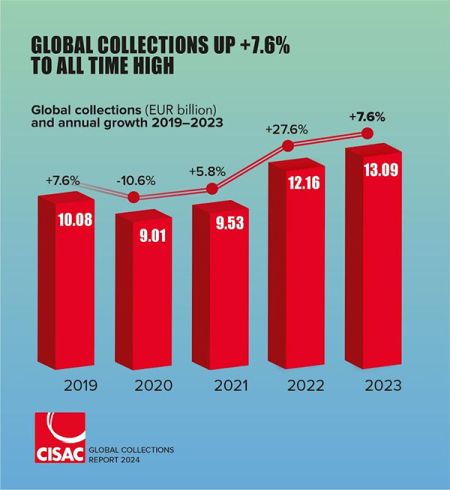
MUMBAI: The Indian Performing Right Society Limited (IPRS) continues to solidify its position as one of the top four revenue-generating societies in the Asia-Pacific region, as indicated by the recently released CISAC Global Collections Report 2024. The report reveals record-breaking global royalty collections, highlighting significant trends in the Indian and Asian music markets. The report reveals that global music collections reached an all-time high of €13.09 billion, representing a 7.6% increase compared to the previous year. While the Indian music landscape continues to expand with promising digital growth, issues related to low compliance and the slow growth of paid subscriptions on streaming platforms continue to hinder the revenue potential for creators and publishers in the Indian music industry.
In 2023, IPRS’s total collections surpassed INR 500 Crores, with digital revenues accounting for 74.2% of this figure. This impressive digital growth, 493.6% over the last five years, reflects India’s evolving digital consumption habits. India is one of the largest consumers of music globally, with millions accessing music daily through multiple digital and streaming platforms. Despite this, the number of paid subscribers in India remains disproportionately low compared to other major markets. The reliance on free, ad-supported tiers significantly limits the revenue generated from streaming, creating a value gap for artists and rights holders.
Another critical concern highlighted in the CISAC report is the issue of fair value and low compliance with copyright and licensing laws in India. Many broadcasters, venues, events and digital platforms fail to adhere to licensing requirements, leading to delayed payments to rights holders and missed opportunities for revenue growth.
The low compliance rate is a major concern for rights management organizations like IPRS, which have been working to improve transparency and strengthen the enforcement of copyright laws. Ensuring that music creators receive fair compensation for the use of their work remains a top priority, but it will require more collaborative efforts between industry players and policymakers to bridge the gaps in the current system.
While digital streaming dominates India's music revenues, the live music industry too holds significant untapped potential. Live and public performances, including concerts and festivals, rebounded strongly in 2023, contributing to a 22% increase in global collections. India, with its rich cultural diversity and growing appetite for live entertainment, is well-positioned to capitalize on this trend.
However, the live music sector in India remains fragmented, with a vast number of organizers and venues across the country needing greater awareness and adoption of music licensing norms and best practices. Enhancing this understanding is essential to ensure that revenue flows equitably to the creators who form the foundation of the music ecosystem. While there is a broad exception in law for marriage-related events, where music usage does not require licensing, it is important to note that other live music performances still require proper licensing to ensure fair compensation for creators. IPRS is actively addressing this gap by promoting industry-wide compliance through its robust licensing network, aiming to diversify revenue streams beyond digital collections and support the thriving live music sector.
Commenting on the same Mr. Javed Akhtar, Chairman of IPRS said, “Our standing as one of the top revenue-generating societies in the Asia-Pacific region truly reflects the incredible creativity and talent that defines India’s music industry. While we are pleased with our growth in digital collections, there are important challenges that we must address, particularly around low compliance and adequate enforcement of copyright laws. We urge for greater support from the industry stakeholders and the administration to unlock the immense potential our music holds and solidify our position on the global stage.”
CISAC Director General Gadi ORON commented, “This Report gives a unique overview of the economic and cultural value of our global CISAC community. This year’s figures, for royalties’ collections by CISAC members in 2023, paint a positive picture of a healthy, stable and promising sector. Overall, collections on behalf of creators reached a new all-time high of EUR13.1bn, an impressive 7.6% increase. During the last five years, CISAC members have added over EUR3bn to the amounts they collect for authors and copyright holders. This, in itself, is a major achievement and shows the strength of the collective management system.”
Mr. Rakesh Nigam, the CEO of the Indian Performing Right Society Limited (IPRS), added, “We are proud of the progress IPRS has made, but we recognize that significant challenges remain. The low compliance rate in India is a serious concern, as it directly affects the earnings of our creators. We are committed to working with industry players to ensure that licensing agreements are properly enforced, and that creators are fairly compensated for their work. At the same time, we see the huge possibilities the live music sector holds, and by focusing on its growth, we aim to complement our already robust digital revenues.”
The CISAC report serves as a reminder that while India’s music industry is thriving, key challenges such as low compliance and a lag in paid subscriptions need to be addressed to ensure sustained growth. Industry stakeholders, music users, and government agencies must collaborate to create a more supportive environment for the music ecosystem.
As the industry moves forward, IPRS remains committed to advocating for creators' rights and promoting the Indian music industry on the world stage. By addressing the current challenges, the industry can unlock new growth opportunities and ensure that India continues to be a key player in the global music economy.